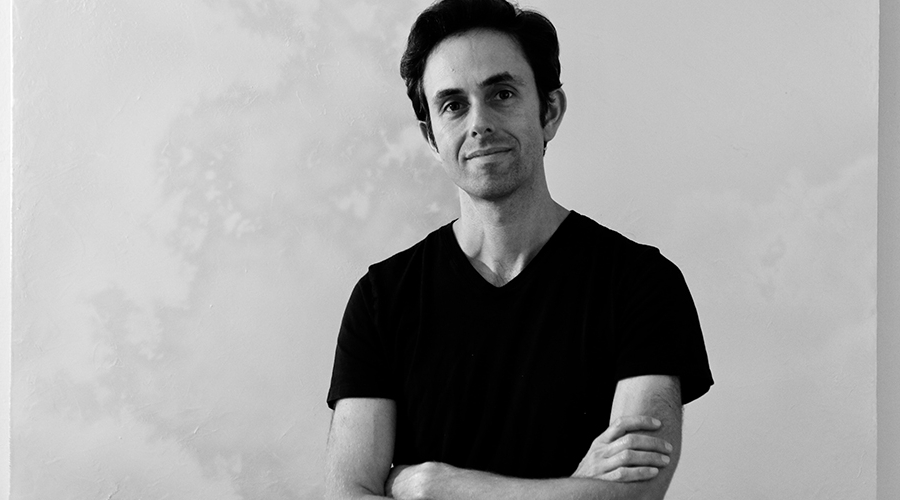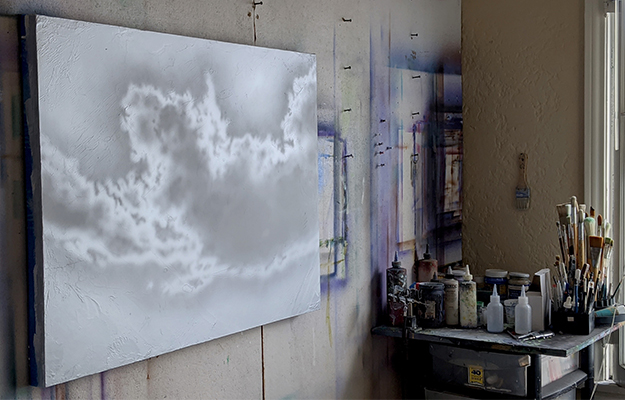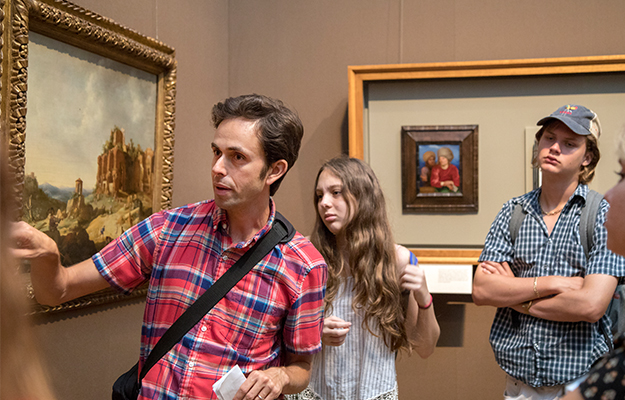
In celebration of the talented faculty at Otis College, we are launching a new regular series, “Quick Questions with Otis College Faculty,” beginning with Roni Feldman, an Adjunct Professor in the Foundation program who was the recipient of a 2021 Teaching Excellence Award. Originally from Los Angeles, Feldman teaches Principles of Design and Connections through Color & Design. He has a bachelor’s degree in Creative Studies from the College of Creative Studies at the University of California, Santa Barbara, and a MFA from Claremont Graduate University. Here, Feldman discusses what he loves about teaching at Otis College, how he gets out of creative ruts, and where he goes to be inspired.
What artist has had the biggest impact on you and your work?
When I was in my early twenties I was living in San Francisco, going to rallies and protests often, and turning what I saw into representational, politically-oriented artwork. This was during the middle of the Iraq War, so many of these were rallies for peace. However, the rallies were rarely peaceful. I became disenchanted with them, feeling that if they were rallies for peace, the protesters should be peaceful. As Ghandi said, “Change yourself, and you’ll change a thousand others.” Around this same time, the De Young Museum opened in Golden Gate Park with a Skyspace by James Turrell. Sitting in this art installation, with its stupa-like architecture and rooftop portal open to the sky, I was instilled with a sense of calm and contemplative quiet. I went home and learned more about Turrell’s work. It changed how I thought about art-making. I began to make art that is not just about symbolic meaning, but creates a richer, engaging experience through the form it takes on. This is also the basis for many of my critiques with students, and is at the heart of how I teach construction of meaning.
 What’s the best way to get out of a creative rut?
What’s the best way to get out of a creative rut?
I have a lot of things that I rely on. My best fallback is to go on a hike by myself—no music, no audiobooks, just me and the sounds of nature. It clears my mind, helps me focus on whatever I am stuck on, and by the time I go out and back, I have a path forward with my work. I also think taking breaks from your usual creative pursuit can help—try cooking or baking something. Go on a short trip if you can, or spend some time reading a book purely for pleasure. As a general practice, go out and see something new—an art show, a movie, a magazine. It almost doesn’t matter what it is. Even things outside of your field can help. I’m a painter but have found inspiration in the colors of jewelry, or the sheen of a well-designed aluminum can. The more you take in, the more chances you have to spark ideas and inspiration.
What’s your favorite spot in L.A. for inspiration or reflection?
The Eagle Rock hike in Topanga State Park is a beautiful hike with views towards both the ocean and the valley. There are actually some caves in the face of the rock overlooking a ravine. I actually decided to become an artist in one of them back when I was in high school.
What’s a common misconception people have about art and design college?
People who don’t go to an art and design college often assume that it’s easy or that it just involves a bunch of undirected play. Play is definitely part of being an artist—it can be how we discover things or figure out solutions. But studying art and design can also be very rigorous. It takes many years of practice and attention to detail to master one’s craft. It can take even longer to figure out the best form for one’s ideas. That may even be a lifetime journey. I think my students at Otis work really hard both in and out of class. A lot of that is self-directed for those who know that you get out of college what you put into it.
 In what ways is Otis unique as an art and design college?
In what ways is Otis unique as an art and design college?
I love that Otis has a dedicated Color Theory course. Not many colleges still have such a class, but as I say the first day of class, “Color is the first thing we see, but the last thing we think about,” meaning it has a huge impact on our choices, preferences, and reactions. It’s a pleasure to explore color in depth and from numerous angles over a whole semester. In my class, we delve into the different color systems and discuss how and where they might be used. We explore the scientific, emotional, and symbolic sides to color and discuss how they apply to the different majors at Otis. I love how the curriculum builds upon what students already learned in Principles of Design so they can really explore the impact that color can have. I hope it makes magic happen for them!
What class would you still love to teach that you haven’t already?
I wish we had even more time in Color Theory! It would be terrific to study how different cultures have made pigments throughout history, then have students make their own pigments and dyes, and apply them in inventive ways.
 What’s the best teaching advice you’ve ever received?
What’s the best teaching advice you’ve ever received?
It was actually art advice, but it translated into how I teach. One of my professors said he wanted to make paintings that were smarter than he was. For him, that meant leaving room for intuition, accidents, and experimentation. I think that’s important for my students as well. I want them to become smarter artists and designers than I am. To foster that, I avoid subjective critiques on personal style or interests, even when teaching very specific goals. What may seem unappealing to one person may very well be the next big thing in art and design. Rather, my goal is to help students more effectively construct meaning, to help them dive deeper into their interests, to enrich and challenge them to consider outside sources and different points of view, while also providing them with a range of technical and conceptual tools for them to better execute their own choices.
Images, from top: Roni Feldman photographed by Caroline Miller; Feldman’s studio; Quicksilver #2 (acrylic on canvas, 27 by 36 inches), all courtesy of Roni Feldman. Bottom image: Feldman during a museum visit with Summer of Art students, photographed by Fawad Assadullah.


